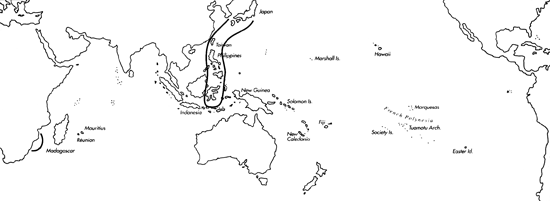
Skip Navigation Links
View access keys for this site.

Range: Typical form: Japan to Taiwan; Natal, South Africa; form nereis: Philippines and Makassar Straits.
Description: Small to moderately small, light to moderately solid; form nereis (Pl. 53, Figs. 19-21) smaller than typical form. Last whorl conical to ventricosely conical, also broadly conical to broadly and ventricosely conical in form nereis; outline straight to convex adapically, straight right side) or concave (left side) below. Shoulder angulate to carinate, with deep exhalant notch. Spire of moderate height to high, outline concave. Larval shell of 3.0-3.5 whorls, maximum diameter 0.85-0.95 mm. First 3-6 postnuclear whorls tuberculate. Teleoconch sutural ramps flat to concave, with arcuate radial threads and often obsolete, fine or coarse spiral striae. Last whorl with axially striate spiral grooves from base to or occasionally beyond centre and 1-4 fine spiral grooves below shoulder; grooves separated by ribs at subshoulder area and by ribbons below.
| Shell Morphometry | ||
|---|---|---|
| L | - | |
| (-typical form 23- 34 mm; -form nereis 20- 27 mm) | ||
| RW | - | |
| (-typical form 0.06- 0.13 g/mm; -form nereis 0.05- 0.10 g/mm) | ||
| RD | - | |
| (-typical form 0.59- 0.70; -form nereis 0.58- 0.76) | ||
| PMD | - | |
| (-typical form 0.77- 0.94; -form nereis 0.82- 0.95) | ||
| RSH | - | |
| (-typical form 0.16- 0.26; -form nereis 0.20- 0.26) | ||
Ground colour white. Last whorl with spiral rows of brown dots varying in number and size. Overlying brown flecks forming 3 solid or interrupted spiral bands, below shoulder, at centre, and near base. Larval whorls white. Postnuclear sutural ramps with irregular brown radia markings, sometimes forming a row of brown dots on shoulder. Aperture white.
Periostracum greyish brown, thin, and translucent on last whorl, opaque and with curved radial ridges on sutural ramps.
Habitat and Habits: In 30-240 m.
Discussion: C. wakayamaensis is most similar to C. eugrammatus, C. memiae, and C. baileyi. The latter species differs in having a usually narrower last whorl (RD 0.51- 0.63) and distinct spiral grooves on the late sutural ramps. C. memiae also differs from C. wakayamaensis in having distinct spiral grooves on the late sutural ramps; the outer margins of its teleoconch sutural ramps have regularly spaced brown dots and its last whorl pattern is more complex with usually narrower white spiral bands centrally. For comparison with C. eugrammatus, see the Discussion of that species. Shells from Philippines described as C. nereis generally are smaller and may be broader but otherwise do not differ significantly from typical C. wakayamaensis. We thus include them as a form in the latter species.

C. wakayamaensis range map
This section contains verbatim reproductions of the accounts of 316 species of Conus from the Indo-Pacific region, from Manual of the Living Conidae, by Röckel, Korn and Kohn (1995). They are reproduced with the kind permission of the present publisher, Conchbooks.
All plates and figures referred to in the text are also in Röckel, Korn & Kohn, 1995. Manual of the Living Conidae Vol. 1: Indo-Pacific Region.
The range maps have been modified so that each species account has it own map, rather than one map that showed the ranges of several species in the original work. This was necessary because each species account is on a separate page on the website and not confined to the order of accounts in the book.
Return to framed version (returns to search page)